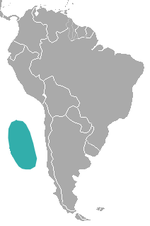Juan Fernández fur seal
| Juan Fernández fur seal | ||||||||||||
|---|---|---|---|---|---|---|---|---|---|---|---|---|

Juan Fernández fur seal in the water |
||||||||||||
| Systematics | ||||||||||||
|
||||||||||||
| Scientific name | ||||||||||||
| Arctocephalus philippii | ||||||||||||
| ( Peters , 1866) |
The Juan Fernández fur seal ( Arctocephalus philippii ) is a very rare species of the southern fur seal .
features
Bulls are up to 2 m long, females around 1.40 m. The weight of a fully grown male is 140 kg, that of a cow 50 kg. In appearance, these fur seals resemble other members of the genus. The bulls have a mane with silver-colored hair tips.
distribution
The only colony lives on the Juan Fernández Islands , an archipelago belonging to Chile , but 670 km from the South American coast.
Inventory development
Late 18th century travelers estimated the populations along the coasts of the two islands of Alejandro Selkirk and Robinson Crusoe to be four million seals. British seal hunters were then dispatched to the islands. Occasionally fifteen ships anchored off the island at the same time, while the hunters killed seals en masse for their skins. With around 250,000 fur seals killed each year, populations collapsed in no time. In 1824 the species was thought to be extinct. Similar to the Guadalupe fur seal , the Juan Fernández fur seal may only have survived because some animals remained hidden in caves and remained undiscovered.
The species was not rediscovered until 1965 and immediately placed under strict protection. The colonies on both islands again comprised 12,000 seals in the 1990s and they are growing steadily.
Hazard and protection
The Juan Fernández fur seal is listed in the Red List of Endangered Species of the World Conservation Organization IUCN as Near Threatened . Like all species of the genus, it is also a species that, according to the Washington Convention on the Protection of Species CITES Appendix II, requires a worldwide trade restriction. The European Union with the EU Species Protection Ordinance 338/97 tightened the protection status, listed in Appendix A and thus pronounced a trade ban. This regulation has a direct influence on the member states of the European Union. The Federal Republic of Germany lists the species as strictly protected in the Federal Nature Conservation Act.
literature
- Ronald M. Nowak: Arctocephalus philippii Walker's Marine Mammals of the World. P. 74, 1st edition. Johns Hopkins University Press, Baltimore MD et al. 2003, ISBN 0-8018-7343-6 .
Web links
- Arctocephalus philippii in the endangered Red List species the IUCN 2009. Posted by: Aurioles, D. & Trillmich, F. (IUCN SSC Pinniped Specialist Group), 2008. Retrieved on January 8 of 2010.
